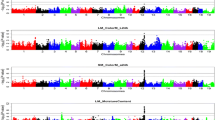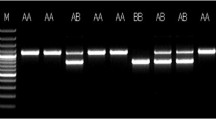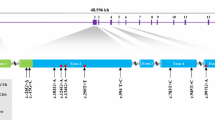Abstract
IGFBP-5 is a member of the IGF families. Using PCR-SSCP, genotypic and allelic frequencies were analyzed in 18 pig breeds (n = 600). The association between haplotypes and production performance was analyzed in a Jinhua × Pietrain population family (n = 212, total 24 traits). Two SNPs (T199C and G485A) within the gene were analyzed. The breeds had different genotypic and allelic frequencies. Typically, the Chinese native pig breeds carried a higher allele C and G frequency (over 50%) than those of the European pigs, and only Guangdong Large White and wild boar were at Hardy–Weinberg equilibrium. The pigs carrying the CG haplotype had higher hue, loin, and thigh pH1 values than pigs with the TA haplotype, and pigs with the TA haplotype had the lowest loin pH2 value and highest color-a value among the haplotypes. It is proposed that the IGFBP-5 gene is associated with the variation in meat quality, especially in pH value together with other QTLs on chromosome 15.
Similar content being viewed by others
References
Bautista CM, Baylink DJ, Mohan S (1991) Isolation of a novel insulin-like growth factor (IGF) binding protein from human bone: a potential candidate for fixing IGF-II in human bone. Biochem Biophys Res Commun 176:756–763
Camacho-Hubner C, Busby WH Jr, McCusker RH, Wright G, Clemmons DR (1992) Identification of the forms of insulin-like growth factor binding proteins produced by human fibroblasts and the mechanisms that regulate their secretion. J Biol Chem 267:11949–11956
Cameron ND (1990) Genetic and phenotypic parameters for carcass traits, meat and eating quality traits in pigs. Livest Prod Sci 26:119–135
Ciobanu D, Bastiaansen J, Malek M, Helm J, Woollard J, Plastow G, Rothschild M (2001) Evidence for new alleles in the protein kinase adenosine monophosphate-activated γ3-subunit gene associated with low glycogen content in pig skeletal muscle and improved meat quality. Genetics 159:1151–1162
De Koning DJ, Rattink AP, Harlizius B, van Arendonk AMJ, Brascamp EW, Groenen MAM (2000) Genome-wide scan for body composition in pigs reveals important role of imprinting. Proc Natl Acad Sci USA 97:7947–7950
Falconer DS, Mackay TFC (1996) Introduction to quantitative genetics. Longman, England
Hedrick PW (1987) Gametic disequilibrium measures: proceed with caution. Genetics 2:331–341
Hovenier R, Kanis E, Van Asseldonk TH, Westerink NG (1992) Genetic parameters of pig meat quality traits in a halothane negative population. Livest Prod Sci 32:309–321
Huff-Lonergan E, Baas TJ, Malek JM, Dekkers CM, Prusa K, Rothschild M (2001) Correlations among selected pork quality traits. J Anim Sci 80:617–627
Jones JI, Clemmons DR (1995) Insulin-like growth factors and their binding proteins: biological actions. Endocr Rev 16:3–34
Kang HS, Qin ZHS, Niu TH, Liu JS (2004) Incorporating genotyping uncertainty in haplotype inference for single-nucleotide polymorphisms. Am J Hum Genet 74:495–510
Looft C, Milan D, Jeon JT, Paul S, Reinsch N, Rogel-Gaillard C, Rey V, Amarger V, Robic A, Kalm E, Chardon P, Andersson L (2000) A high-density linkage map of the RN region in pigs. Genet Sel Evol 32:321–329
Malek M, Dekkers JCM, Lee Ho K, Baas TJ, Prusa K, Huff-Lonergan E, Rothschild MF (2001) A molecular genome scan analysis to identify chromosomal regions influencing economic traits in the pig (II). Meat and muscle composition. Mamm Genome 12:637–645
Mariani P, Lundström K, Gustafsson U, Enfalt AC, Juneja RK, Andersson L (1996) A major locus (RN) affecting muscle glycogen content is located on pig chromosome 15. Mamm Genome 7:52–54
Milan D, Woloszyn N, Yerle M, Le Roy P, Bonnet M, Riquet J, Lahbib-Mansais Y, Caritez JC, Robic A, Sellier P, Elsen JM, Gellin J (1996) Accurate mapping of the acid meat RN gene on genetic and physical maps of pig chromosome 15. Mamm Genome 7:47–51
Miyakoshi N, Richman C, Kasukawa Y, Linkhart TA, Baylink DJ, Mohan S (2001) Evidence that IGF-binding protein-5 functions as a growth factor. J Clin Invest 107:73–81
Mohan S, Baylink DJ (2002) IGF-binding proteins are multifunctional and act via IGF-dependent and -independent mechanisms. J Endocrinol 175:19–31
Müller E, Moser G, Bartenschlager H, Geldermann H (2000) Trait values of growth, carcass and meat quality in Wild Boar, Meishan and Pietrain pigs as well as their crossbred generations. J Anim Breed Genet 117:189–202
Rechler MM (1993) Insulin-like growth factor binding proteins. Vit Horm 47:1–114
Roghani M, Hossenlopp P, Lepage K, Balland A, Binoux M (1989) Isolation from human cerebrospinal fluid of a new insulin-like growth factor binding protein with selective affinity for IGF-II. FEBS Lett 255:253–258
Rohrer GA, Alexander LJ, Beattie CW (1997) Mapping genes located on human chromosomes 2 and 12 to porcine chromosomes 15 and 5. Anim Genet 28:448–450
SAS (1989) SAS user’s guide. SAS Institute Inc, Cary, NC
Sellier P (1998) Genetics of meat and carcass traits. In: Rothschild MF, Ruvinsky A (eds) The genetics of the pig. CAB International, Wallingford, UK, pp 463–510
Shimasakai S, Shimonaka M, Zhang H, Ling N (1991) Identification of five different insulin-like growth factor binding proteins (IGFBPs) from adult rat serum and molecular cloning of a novel IGFBP-5 in rat and human. J Biol Chem 266:10646–10653
Song SH, Lee CY, Green ML, Chung CS, Simmen RCM, Simmen FA (1996) The unique endometrial expression and genomic organization of the porcine IGFBP-2 gene. Mol Cell Endocrinol 120:193–202
Sonstegard TS, Rohrer GA, Smith TP (1998) Myostatin maps to porcine chromosome 15 by linkage and physical analyses. Anim Genet 29:19–22
Wang W (2006) Nucleotide variation study of the insulin-like growth factor binding protein 1 ~ 6 genes in swine. Thesis for doctoral degree. China Agricultural University, Beijing
White ME, Diao R, Hathaway MR, Mickelson J, Dayton WR (1996) Molecular cloning and sequence analysis of the porcine insulin-like growth factor binding protein-5 complementary deoxyribonucleic acid. Biochem Biophys Res Commun 218:248–253
Acknowledgments
This study was supported by the State Key Basic Research and Development Program (G200000161) and Doctoral Initiation Fund of Jiangxi Agricultural University. The authors thank Prof. Xu Ningyin, Zhejiang University, Zhejiang, P. R. China, for his kind donation of the Jinhua × Pietrain population family.
Author information
Authors and Affiliations
Corresponding author
Rights and permissions
About this article
Cite this article
Wang, W., Ouyang, K., Shangguan, X. et al. Association of Porcine IGF Binding Protein-5 Gene with Meat Quality. Biochem Genet 48, 257–265 (2010). https://doi.org/10.1007/s10528-009-9315-6
Received:
Accepted:
Published:
Issue Date:
DOI: https://doi.org/10.1007/s10528-009-9315-6




